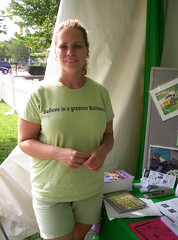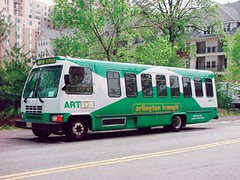Government engaging people in the community
I have been meaning to write about citizen participation from the ground up, because of various programs in Baltimore, versus how things are done in the District of Columbia.
One of the problems of "one thousand points of light" and the conservative focus on faith institutions and whatnot in terms of providing services and capacity and community building at the neighborhood and city level is that the problems and issues we face:
-- often exceed the expertise and understanding of the average citizen; and
-- require systematic, structured, and structural responses that go beyond soup kitchens.
Now, in response to that you can either (1) do it for people; or (2) work with people and communities to develop and strengthen their skills and capacities, along with goodly doses of expertise and knowledge building. The first is what I call "governmentalizing" things. Sociologists often call this "learned helplessness" or "infantilization."
This relates to something I started saying back in my college days, "that you don't educate people in relatively authoritarian settings for 13-17 years of their lives, and then upon graduation, expect them to become active, free-thinking, participating members of society."
We need to exercise being engaged, or we won't do it. Just like how we forget how to do statistics calculations, unless we do this kind of analysis day to day...
I think that government institutions play a key role, because they are the only institutions charged with maintaining oversight and being engaged in various programmatic areas, be it the provision of emergency services or neighborhood planning or education.
The difference is that I think the agencies need to change how they conceptualize their mission, which should include citizen enabling and engagement.
So, along these lines, David Francis has had two good pieces in the Examiner over the past couple days:
1. "Arlington County seeking stream cleanup volunteers" discusses how:
Arlington County is seeking volunteers for an Aug. 26 cleanup of streams flooded by this summer’s heavy rains. Stream water rose to dangerous levels during record-setting rains earlier this summer. Many of the streams are still littered with trash and other debris.
“We do [a clean up] annually in March,” said Arlington conservation manager Lynne Everly. “We decided to do another one because of the damage caused by the storm.”
2. The other article, "Arlington teens provide transport advice," is about how Arlington County has created a youth advisory committee to engage youth in transit planning. From the article:
Arlington County Transit provides public transportation that supplements the regional Metro and Metrobus systems. Earlier this year, county board Chair Chris Zimmerman announced the teen initiative to get young people’s input on the transportation system.
“It seemed like a really good opportunity to expand service to a segment of the population that can use [transit] and learn from them,” he said. “They’re users [of the system], and they can identify a number of areas we can work on.”
Teens “are a large part of the population when many times driving is not an option,” he said. “The transit system should be a good option for them to get around. We think the transit system can serve them better.”
To start the program, about 700 teens in Arlington were surveyed on the transportation system. The survey found teens believed bus service to be confusing, fares too high and parents who were reluctant to allow their children to ride the bus.
“We have to get better information out there,” Zimmerman said. “We have to make it easier to figure out how to use the system.”
But I have been thinking about this broad issue a lot because of various programs in the City of Baltimore, such as the Live Baltimore resident attraction program, which relies on volunteers, and the various citizen engagement activities that they promote through their weekly e-newsletter.
 Kimberly Mead, Urban Forest Ecologist, addresses Invasive Plant Control for the Baltimore Dept. of Recreation and Parks. She leads the "Weed Warriors" program.
Kimberly Mead, Urban Forest Ecologist, addresses Invasive Plant Control for the Baltimore Dept. of Recreation and Parks. She leads the "Weed Warriors" program.Another project is the City's "weed warriors" program, which involves residents in working to rid parks of invasive weeds. Think of it as a garden party where you get your hands dirty. They publish a monthly e-newsletter, and hold events every month or so. Last week, it was cutting invasive vines in Patapsco Park.
In the crime and public safety arena, one of the problems of youth and crime is activities and ways of engaging children and adolescents, instead of for the most part, communicating to them that they are worth very little.
I came across a couple journals that look at these issues from a variety of perspectives, but mostly report on projects where youths are actively engaged. Many of the articles in the two journals, Children, Youth and Environments and CYD (Community Youth Development) Journal, are online.
There are more and better ways to deal with youth than merely imposing a curfew. Other things I have been thinking about include offering a co-operative education model at the high school level, as well as the conversion of DC's "Summer Youth Employment" program into more of a "Civilian Conservation Corps/Works Progress Administration" feel, oriented to community-public engagement and "public works" of various sorts.
Finally, one of the major reasons for the difficulties of the various Main Street programs in DC is a weak culture for community involvement and engagement--which is where this blog entry started. Most urban Main Street programs are somewhat arrogant, and figure they have little to learn from "small town" programs. Given that I believe that I can learn from anyone and everywhere, I have always thought that foolish.
And an article from the Ottumwa Courier, "Main Street emphasizes need for public involvement," makes the point. From the article:
“The program belongs to you. It belongs to the community and the volunteers who drive it. The reason for that is the town’s going to be here forever and, hopefully, the Main Street program is going to be here for a long time,” she said.
Broad ownership requires broad participation. Cities that achieve that broad base of participants can also begin to tap a much deeper reservoir of funding. Glasscock said Main Street programs must become effective partners who are at ease in both the public and private sectors. ...
Glasscock said the program can lead cities in unexpected directions. Keokuk business owners prior to the Main Street program focused on sales and discounts to bring in customers. Such efforts have their place, Glasscock said, but they cannot be the sole means for attracting customers. Wider events that bring businesses together as partners can be just as effective.
“You can have a promotion that is nothing related to a discount and bring people to downtown,” she said. “We were changing minds about how people think about downtown. We were changing attitudes.” ...
Sales and festivals are part of a positive cycle. The events bring people downtown, which helps businesses attract customers. An active downtown, in turn, encourages business owners to keep their businesses clean and pressures property owners to do the same. It also makes prospective business owners more likely to consider opening downtown. A clean, well-maintained downtown creates an atmosphere that helps attract people, thus spurring events and creating sales.
Main Street officials cannot guarantee anything, but they can stack the deck as much as possible in their cities’ favor. Iowa’s experience shows that, in many cases, that’s enough.
Given the increasingly zero-sum financial situation that most communities face, successful places utilize social and organizational capital and capacity, not just money, to stabilize, improve, and extend the livability of their communities.
Index Keywords: civic-engagement




0 Comments:
Post a Comment
<< Home